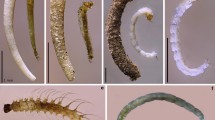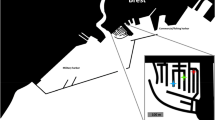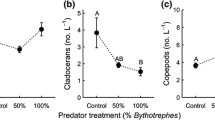Abstract
Crabs are some of the most successful introduced species among marine organisms, and they can be an important structuring force in marine communities. Recently, the North American white-fingered mud crab, Rhithropanopeus harrisii, has invaded the Northern Baltic Sea. This is an area where no native crab species exist, and the addition of a novel functional species to the low species diversity of the Baltic Sea could have large community-level impacts i.e. modifying biotic interactions and/or altering ecosystem functioning. We examined the predatory behavior of introduced R. harrisii both in the laboratory and field focusing in shallow, hard bottom habitats dominated by the alga Fucus vesiculosus. In the laboratory environment, R. harrisii was an effective predator of littoral grazers, readily consuming both sessile fauna (Mytilus trossulus) and also mobile species such as isopods (Idotea balthica) and gammarid amphipods (Gammarus sp.). When studying the predation of different sized prey items, R. harrisii preyed upon small and medium sized prey of both mobile and sessile species. However, in the field experiment with the native faunal community associated with F. vesiculosus, R. harrisii negatively impacted only the abundance of the snail Theodoxus fluviatilis, possibly through indirect effects. Nevertheless, R. harrisii significantly decreased both the prey species richness and diversity but not the total number of potential prey individuals associated with F. vesiculosus. In conclusion, predatory behavior of this novel crab has the potential to impact the native macroinvertebrate littoral community, but the realized predation pressure in the field is lower than could be expected from laboratory experiments.



Similar content being viewed by others
References
Bacevičius E, Gasiūnaitė ZR (2008) Two crab species-Chinese mitten crab (Eriocheir sinensis Edw.) and mud crab (Rhithropanopeus harrisii (Gould) ssp. tridentatus (Maitland) in the Lithuanian coastal waters, Baltic Sea. Transit Waters Bull 2:63–68. doi:10.1285/i1825229Xv2n2p63
Bishop MJ, Byers JE (2015) Predation risk predicts use of a novel habitat. Oikos. doi:10.1111/oik.01967
Bonsdorff E (2006) Zoobenthic diversity-gradients in the Baltic Sea: continuous post-glacial succession in a stressed ecosystem. J Exp Mar Biol Ecol 330:383–391. doi:10.1016/j.jembe.2005.12.041
Brousseau DJ, Filipowicz A, Baglivo JA (2001) Laboratory investigations of the effects of predator sex and size on prey selection by the Asian crab, Hemigrapsus sanguineus. J Exp Mar Biol Ecol 262:199–210. doi:10.1016/S0022-0981(01)00290-8
Buck TL, Breed GA, Pennings SC, Chase ME, Zimmer M, Carefoot TH (2003) Diet choice in an omnivorous salt-marsh crab: different food types, body size, and habitat complexity. J Exp Mar Biol Ecol 292:103–116. doi:10.1016/S0022-0981(03)00146-1
Cohen AN, Carlton JT, Fountain MC (1995) Introduction, dispersal and potential impacts of the green crab Carcinus maenas in San Francisco Bay, California. Mar Biol 122:225–237
Compton TJ, Leathwick JR, Inglis GJ (2010) Thermogeography predicts the potential global range of the invasive European green crab (Carcinus maenas). Divers Distrib 16:243–255. doi:10.1111/j.1472-4642.2010.00644.x
Coverdale TC, Axelman EE, Brisson CP, Young EW, Altieri AH, Bertness MD (2013) New England salt marsh recovery: opportunistic colonization of an invasive species and its non-consumptive effects. PLoS ONE 8:e73823. doi:10.1371/journal.pone.0073823
Cox JG, Lima SL (2006) Naiveté and an aquatic-terrestrial dichotomy in the effects of introduced predators. Trends Ecol Evol 21:674–680. doi:10.1016/j.tree.2006.07.011
Czerniejewski P, Rybczyk A (2008) Body weight, morphometry, and diet of the mud crab, Rhithropanopeus harrisii tridentatus (Maitland, 1874) in the Odra estuary, Poland. Crustaceana 81:1289–1299. doi:10.1163/156854008X369483
Demel K (1953) Nowy gatunek w faunie Baltyku. Kosmos 2:105–106
Dineen JF, Clark PF, Hines AH, Reed SA, Walton HP (2001) Life history larval description and natural history of Charybdis hellerii (Decapoda:Brachyura:Portunidae) and invasive crab in the Western Atlantic. J Crustacean Biol 21:774–805. doi:10.1651/0278-0372(2001)021[0774:LHLDAN]2.0.CO;2
Elton CS (1958) The ecology of invasions by animals and plants. Methuen, London
Engkvist R, Malm T, Tobiasson S (2000) Density dependent grazing effects of the isopod Idotea baltica Pallas on Fucus vesiculosus L in the Baltic Sea. Aquat Ecol 34:253–260. doi:10.1023/A:1009919526259
Fowler AE, Forsström T, von Numers M, Vesakoski O (2013) The North American mud crab Rhithropanopeus harrisii (Gould, 1841) in newly colonized Northern Baltic Sea: distribution and ecology. Aquat Invasion 8:89–96. doi:10.3391/ai.2013.8.1.10
Glude JB (1955) The effects of temperature and predators on the abundance of the softshell clam Mya arenaria in New England. Trans Am Fish Soc 84:13–26
Grosholz ED, Ruiz GM (1995) Spread and potential impact of the recently introduced European green crab Carcinus maenas, in central California. Mar Biol 122:239–247
Grosholz ED, Ruiz GM, Dean CA, Shirley KA, Maron JL, Connors PG (2000) The impacts of a nonindigenous marine predator in a California Bay. Ecology 81:1206–1224. doi:10.1890/0012-9658(2000)081[1206:TIOANM]2.0.CO;2
Haahtela I (1965) Morphology, habitats and distribution of species of the Jaera albifrons group (Isopoda, Janiridae) in Finland. Ann Zool Fennici 2:309–314
Hanks RW (1961) Chemical control of the green crab Carcinus maenas (L.). Proc Natl Shellfish Assoc 52:75–86
Hegele-Drywa J, Normant M (2009) Feeding ecology of the American crab Rhithropanopeus harrisii (Crustacea, Decapoda) in the coastal waters of the Baltic Sea. Oceanologia 51:361–375. doi:10.5697/oc.51-3.361
Holdredge C, Bertness MD, Altieri AH (2009) Role of crab herbivory in die-off of New England salt marshes. Conserv Biol 23:672–679. doi:10.1111/j.1523-1739.2008.01137.x
Hollebone AL, Hay ME (2008) An invasive crab alters interaction webs in a marine community. Biol Invasions 10:347–358. doi:10.1007/s10530-007-9134-9
Honkanen T, Jormalainen V (2005) Genotypic variation in tolerance and resistance to fouling in the brown alga Fucus vesiculosus. Oecologia 144:196–205. doi:10.1007/s00442-005-0053-0
Jacobsen HP, Stabell OB (1999) Predator-induced alarm responses in the common periwinkle, Littorina littorea: dependence on season, light conditions, and chemical labelling of predators. Mar Biol 134:551–557. doi:10.1007/s002270050570
Jacobsen HP, Stabell OB (2004) Source antipredator behaviour mediated by chemical cues: the role of conspecific alarm signaling and predator labeling in the avoidance response of a marine gastropod. Oikos 104:43–50. doi:10.1111/j.0030-1299.2004.12369.x
Juanes F (1992) Why do decapod crustaceans prefer small-sized molluscan prey? Mar Ecol Prog Ser 87:239–249
Juanes F, Hartwick EB (1990) Prey size selection in Dungeness crabs: the effect of claw damage. Ecology 71:744–758
Karhilahti A (2010) Taskurapu tarttui pyydykseen. Suomen luonto 4:12–13
Kautsky H, Kautsky L, Kautsky N, Kautsky U, Lindblad C (1992) Studies on the Fucus vesiculosus community in the Baltic Sea. Acta Phytogeogr Suec 78:33–48
Kennedy TA, Naeem S, Howe KM, Knops JMH, Tilman D, Reich P (2002) Biodiversity as a barrier to ecological invasion. Nature 417:636–638. doi:10.1038/nature00776
Kimbro DL, Grosholz ED, Baukus AJ, Nesbitt NJ, Travis NM, Attoe S, Coleman-Hulbert C (2009) Invasive species cause large-scale loss of native California oyster habitat by disrupting trophic cascades. Oecologia 160:563–575. doi:10.1007/s00442-009-1322-0
Korpinen S, Jormalainen V, Honkanen T (2007) Bottom-up and cascading top-down control of macroalgae along a depth gradient. J Exp Mar Biol Ecol 343:52–63. doi:10.1016/j.jembe.2006.11.012
Kotta J, Ojaveer H (2012) Rapid establishment of the alien crab Rhithropanopeus harrisii (Gould) in the Gulf of Riga. Est J Ecol 61:293–298. doi:10.3176/eco.2012.4.04
Ledesma ME, O’Connor NJ (2001) Habitat and diet of the non-native crab Hemigrapsus sanguineus in southeastern New England. Northeast Nat 8:63–78. doi:10.2307/3858263
Lefebvre L, Reader SM, Sol D (2004) Brains, innovations and evolution in birds and primates. Brain Behav Evol 63:233–246. doi:10.1159/000076784
Lonsdale WM (1999) Global patterns of plant invasions and the concept of invisibility. Ecology 80:1522–1536. doi:10.1890/0012-9658(1999)080[1522:GPOPIA]2.0.CO;2
Lubchenco J (1978) Plant species diversity in a marine intertidal community: importance of herbivore food preference and algal competitive abilities. Am Nat 112:23–39
Mach ME, Bourdeau PE (2011) To flee or not to flee? Risk assessment by a marine snail in multiple cue environments. J Exp Mar Biol Ecol 409:166–171. doi:10.1016/j.jembe.2011.08.018
Magurran AE (2004) Measuring biological diversity. Blackwell Science Ltd, UK
Marko PB, Palmer AR (1991) Responses of a rocky shore gastropod to the effluents of predatory and non-predatory crabs: avoidance and attraction. Biol Bull 181:363–370. doi:10.2307/1542356
Mascaro M, Hidalgo LE, Chiappa-Carrara X, Simoes N (2003) Size-selective foraging behaviour of blue crabs, Callinectes sapidus (Rathbun), when feeding on mobile prey: active and passive components of predation. Mar Freshw Behav Physiol 36:143–159. doi:10.1080/10236240310001603224
Milke LM, Kennedy VS (2001) Mud crabs (Xanthidae) in Chesapeake Bay: claw characteristics and predation on epifaunal bivalves. Invertebr Biol 120:67–77
Naeem S, Knops JMH, Tilman D, Howe KM, Kennedy T, Gale S (2000) Plant diversity increases resistance to invasion in the absence of covarying extrinsic factors. Oikos 91:97–108. doi:10.1034/j.1600-0706.2000.910108.x
Ojeda FP, Dearborn JH (1991) Feeding ecology of benthic mobile predators: experimental analyses of their influence in rocky subtidal communities of the Gulf of Maine. J Exp Mar Biol Ecol 149:13–44
Paavola M, Olenin S, Leppäkoski E (2005) Are invasive species most successful in habitats of low native species richness across European brackish water seas? Estuar Coast Shelf Sci 64:738–750. doi:10.1016/j.ecss.2005.03.021
Roche DG, Torchin ME (2007) Established population of the North American Harris mud crab, Rhithropanopeus harrisii (Gould 1841) (Crustacea: Brachyura: Xanthidae) in the Panama Canal. Aquat Invasion 2:155–161. doi:10.3391/ai.2007.2.3.1
Roche DG, Torchin ME, Leung B, Binning SA (2009) Localized invasion of the North American Harris mud crab, Rhithropanopeus harrisii, in the Panama Canal: implications for eradication and spread. Biol Invasions 11:983–993. doi:10.1007/s10530-008-9310-6
Ross DJ, Johnson CR, Hewitt CL, Ruiz GM (2004) Interaction and impacts of two introduced species on a soft-sediment marine assemblage in SE Tasmania. Mar Biol 144:747–756. doi:10.1007/s00227-003-1223-4
Rudnick D, Resh V (2005) Stable isotopes, mesocosms and gut content analysis demonstrate trophic differences in two invasive decapod crustaceans. Freshw Biol 50:1323–1336. doi:10.1111/j.1365-2427.2005.01398.x
Rudnick DA, Chan V, Resh VH (2005) Morphology and impacts of the burrows of the Chinese Mitten crab, Eriocheir sinensis H. Milne Edwards (Decapoda, Grapsoidea), in south San Francisco Bay, California, U.S.A. Crustaceana 78:787–807. doi:10.1163/156854005774445500
Schubert K (1936) Pilumnopeus tridentatus Maitland, eine neue Rundkrabbe in Deutschland. Zool Anz 116:320–323
Segerstråle SG (1944) Über die Verbreitung der Idotea-Arten im baltischen Meeresgebiet Finnlands. Comment Biol 9:1–6
Sih A, Bolnick DI, Luttbeg B, Orrock JL, Peacor SD, Pintor LM, Preisser E, Rehage JS, Vonesh JR (2010) Predator-prey naiveté, antipredator behavior, and the ecology of predator invasions. Oikos 119:610–621. doi:10.1111/j.1600-0706.2009.18039.x
Silliman BR, Bertness MD (2002) A trophic cascade regulates salt marsh primary production. Proc Natl Acad Sci USA 99:10500–10505. doi:10.1073/pnas.162366599
Smallegange IM, Hidding B, Eppenga JMA, van der Meer J (2008) Optimal foraging and risk of claw damage: How flexible are shore crabs in their prey size selectivity? J Exp Mar Biol Ecol 367:157–163. doi:10.1016/j.jembe.2008.09.011
Stachowicz JJ, Fried H, Osman RW, Whitlatch RB (2002) Biodiversity, invasion resistance, and marine ecosystem function: reconciling pattern and process. Ecology 83:2575–2590
Stohlgren TJ, Binkley D, Chong GW, Kalkhan MA, Schell LD, Bull KA, Otsuki Y, Newman G, Bashkin M, Son Y (1999) Exotic plant species invade hot spots of native plant diversity. Ecol Monogr 69:25–46. doi:10.1890/0012-9615(1999)069[0025:EPSIHS]2.0.CO;2
Strauss SY (2014) Ecological and evolutionary responses in complex communities: implications for invasions and eco-evolutionary feedbacks. Oikos 123:257–266. doi:10.1111/j.1600-0706.2013.01093.x
Tilman D (1999) The ecological consequences of changes in biodiversity: a search for general principles. Ecology 80:1455–1474. doi:10.1890/0012-9658(1999)080[1455:TECOCI]2.0.CO;2
Trussell GC, Ewanchuk PJ, Bertness MD (2002) Field evidence of trait-mediated indirect interactions in a rocky intertidal food web. Ecol Lett 5:241–245. doi:10.1046/j.1461-0248.2002.00304.x
Turoboyski K (1973) Biology and ecology of the crab Rhithropanopeus harrisii ssp. tridentatus. Mar Biol 23:303–313. doi:10.1007/BF00389338
Van Dolah RF (1978) Factors regulating the distribution and population dynamics of the amphipod Gammarus palustris in an intertidal salt marsh community. Ecol Monogr 48:191–217
Vazquez D (2006) Exploring the relationship between niche breadth and invasion success. In: Cadotte MW, McMahon SM, Fukami T (eds) Conceptual ecology and invasions biology: reciprocal approaches to nature. Springer, Berlin, pp 307–322. doi:10.1007/1-4020-4925-0_14
Walton WC, MacKinnon C, Rodriguez LF, Proctor C, Ruiz GM (2002) Effect of an invasive crab upon a marine fishery: green crab, Carcinus maenas, predation upon a venerid clam, Katelysia scalarina, in Tasmania (Australia). J Exp Mar Biol Ecol 272:171–189. doi:10.1016/S0022-0981(02)00127-2
Weis JS (2010) The role of behavior in the success of invasive crustaceans. Mar Freshw Behav Physiol 43:83–98. doi:10.1080/10236244.2010.480838
Wikström SA, Kautsky L (2007) Structure and diversity of invertebrate communities in the presence and absence of canopy-forming Fucus vesiculosus in the Baltic Sea. Estuar Coast Shelf Sci 72:168–176. doi:10.1016/j.ecss.2006.10.009
Wolff T (1954) Occurrence of two East American species of crabs in European waters. Nature 174:188–189
Acknowledgments
The study was financed by the Nottbäck foundation (AF), University of Turku graduate school (TF), and Suomen luonnonsuojelun säätiö. We would like to thank Henry Hellström for providing us with Rhithropanopeus harrisii in 2011. We are grateful for the comments from Veijo Jormalainen and two anonymous reviewers that greatly improved the manuscript.
Author information
Authors and Affiliations
Corresponding author
Rights and permissions
About this article
Cite this article
Forsström, T., Fowler, A.E., Manninen, I. et al. An introduced species meets the local fauna: predatory behavior of the crab Rhithropanopeus harrisii in the Northern Baltic Sea. Biol Invasions 17, 2729–2741 (2015). https://doi.org/10.1007/s10530-015-0909-0
Received:
Accepted:
Published:
Issue Date:
DOI: https://doi.org/10.1007/s10530-015-0909-0




